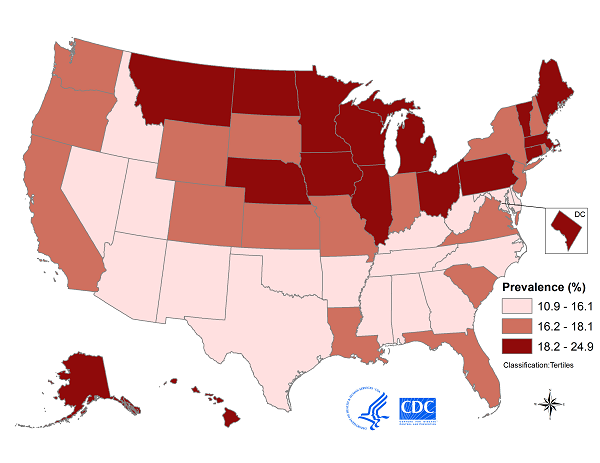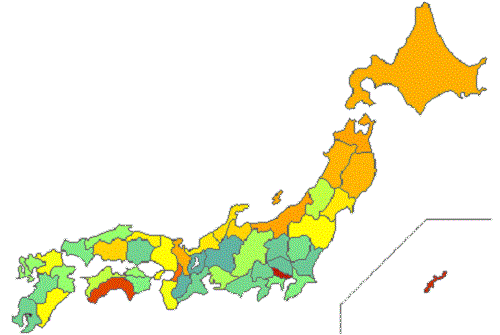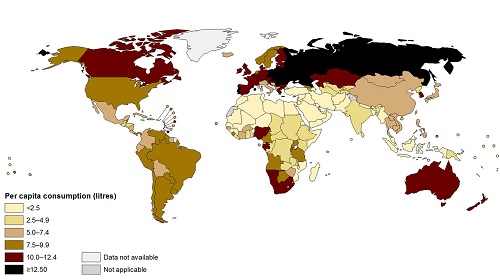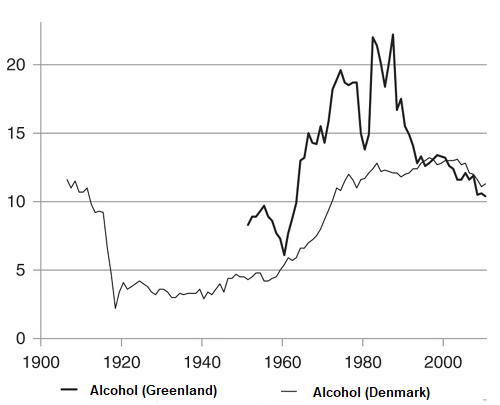[Content warning: suicide, rape, child abuse. Thanks to MC for some help with research.]
I.
Guyana has the highest national suicide rate in the world, 30 people per year per 100,000. Guyana has poverty and crime and those things, but no more so than neighboring Brazil (suicide rate of 6) or Venezuela (suicide rate of 4). What’s going on?
One place to start: Guyana is a multi-ethnic country. Is its sky-high suicide rate focused in one ethnic group? The first answer I found was this article by a social justice warrior telling us it constitutes racial “essentialism” to even ask the question. But in the process of telling us exactly what kind of claims we should avoid, she mentions someone bringing up that “80% of the reported suicides are carried out by Indo-Guyanese”. I feel like one of those classicists who has reconstructed a lost heresy through hostile quotations in Irenaeus.
Indo-Guyanese aren’t American Indians; they’re from actual India. Apparently thousands of Indians immigrated to Guyana as indentured laborers in the late 1800s. Most went to Guyana, and somewhat fewer went to neighboring Suriname. Suriname also has a sky-high suicide rate, but slightly less than Guyana’s, to the exact degree that its Indian population is slightly less than Guyana’s. Basically no Indians went anywhere else in South America, and nowhere else in South America has anywhere near the suicide rate of these two countries. The most Indian regions of Guyana also have the highest suicide rate. Hmmm.
Does India itself have high suicide rates? On average, yes. But India has a lot of weird suicide microclimates. Statewide rates range from from 38 in Sikkim (higher than any country in the world) to 0.5 in Bihar (lower than any country in the world except Barbados). Indo-Guyanese mostly come from Bihar and other low-suicide regions. While I can’t rule out that the Indo-Guyanese come from some micro-micro-climate of higher suicidality, this guy claims to have traced them back to some of their ancestral villages and found that those villages have low suicide rates.
So what’s going on? Social and Cultural Dimensions of Indian Indentured Labour and Its Diaspora argues that despite the mixed suicide rates in India itself, rates across the Indian Diaspora are universally high. For example:
The Fiji Indian suicide rate in the period 1900 to 1915 was the highest among all Indian labour importing colonies in Africa and the West Indies, and much higher than in India itself. In Mauritius too, hundreds of indentured Indian laborers committed suicide by jumping from a particular hillock during the indenture period, which acquired the name of ‘Suicide Hill’, now turned into a monument […]
In his article ‘Veil of Dishonor’ Lal (1985) describes what officials tend to point out as the primary cause of the Fiji Indian suicides: sexual jealousy arising from the persistent shortage of women on the plantations. The rate of indentured adult Indian females to males in Fiji was only 43 to 100. The intense competition for women among the indentured men was seen as the main reason for male suicides in Fiji. Lomarsh Roopnarine (2007) also shows high rates of suicides among indentured Indians in British Guiana […]
Although there is no reason to doubt the existence of sexual jealousy, this emphasis on the scarcity of women disregards the arduous circumstances in which the indentured labourers were working, and the disruption of the “integrative institutions” of society – family, marriage, caste, kinship, and religion – as the underlying causes of suicide and other ills affecting the Indian indentured labour population.
Yeah, but arduous circumstances affected dozens of different ethnicities involved in various colonization and forced labor schemes, and most of them didn’t have these kinds of suicide rates. I can kind of imagine a story where first-generation laborers had no hope of settling down or raising families, committed suicide at high rates, and that ingrained suicidal tendencies in the culture that never went away. But then how come that didn’t happen to eg indentured Englishmen in Virginia?
The incongruously named Vijayakumar and John (2018) blame the Hindu religion. Did you know that the Ramayana ends with Rama, three of brothers, and the entire population of his kingdom committing mass suicide by drowning? Or that the mahaparasthana is a traditional Hindu method of suicide “where the person walks in a north easterly direction, subsisting only on water and air, until his body sinks to rest”? Any religion that has a traditional direction to walk in while you’re committing suicide by starving yourself seems kind of suspicious here. But then how come Hindus in some parts of India have such low suicide rates? How come it’s just the diaspora that suffers. The paper suggests maybe it’s because religiosity plays a protective effect, but it sounds kind of strained.
I don’t have better answers to any of these questions. Maybe the combination of Hindu religion, imbalanced gender ratios, and uprooted communities created a perfect storm. I don’t have any better ideas.
II.
Guyana, at 30 suicides per year per 100,000, is the highest national suicide rate in the world. But if Greenland ever wins independence, it will steal first place. Greenland’s suicide rate is 83 per year per 100,000, almost three times higher than any other country in the world.
Like Guyana, this is more ethnic than national. Greenland is mostly Inuit, and Inuit everywhere have equally high suicide rates. The suicide rate in the mostly-Inuit Canadian province of Nunavit is 71 (for comparison, Canada in general is 10). The suicide rate among Alaskan Inuit is 40 (for comparison, the US in general is 14).
This definitely is not just because of the cold and darkness. White Alaskans who live right next to Alaskan natives have a rate of about 20, not much higher than the US average. And suicide in Greenland – like everywhere else – peaks in the spring and summer anyway.
Most damning of all, Greenland’s high suicide rates are a recent phenomenon. In 1971, the rate was 4. I didn’t forget a zero there. Fifty years ago, Greenland had one of the lowest suicide rates in the world. But by 1990, it had reached 120 (it’s since come down a little bit). What happened in those twenty years?
You would think limiting it to such a short time period would make things easy. It isn’t. There are two main theories: social alienation, and alcohol.
There is definitely a lot of social alienation. For centuries, the Inuit hunted seals in traditional villages. At some point the Danish government decided that was unacceptably backwards and resettled them in cities, especially the capital of Nuuk. This didn’t go well.
One counterargument to this story is that Nuuk has the lowest suicide rate in Greenland, and the more remote the village, the worse the suicide crisis. Maybe you could argue that everywhere was modernized and disrupted and alienated but at least a big city has some interesting stuff to do. This would kind of match the American experience, where it’s small towns in West Virginia that are getting hit by the opioid crisis and deaths of despair.
Another counterargument is that all Native American communities suffered a lot of displacement and alienation and modernization, but none of them suffered the same suicide spike as the Inuit. Sources disagree on the exact Native American suicide rate in the US, but it isn’t unusually high; the CDC numbers say it is slightly below the rate for non-Hispanic whites. Canadian First Nations suicide rates are elevated, but still only a third or so of Inuit levels. Maybe Inuits suffered stronger relocation pressures than other native peoples because of their Arctic environment? Or maybe every native group suffered a suicide spike, but Native Americans and Canadians have adjusted by now and their suicide rates have come back down? I’m not sure.
The other theory about Greenland is alcohol. Alcohol consumption in Greenland skyrocketed around the same time suicide did, reached levels that temporarily made Greenland by far the most alcoholic country in the world – then started declining around the same time suicide did. This seems to be a pattern when hunter-gatherers with no genetic or cultural resistance encounter alcohol for the first time – Native Americans in the 1700s got up to some crazy stuff.
But the Inuit seem to have gotten it much worse. Now we can bring back in the cold and darkness. Alcohol consumption seems to increase reliably with latitude, whether we’re talking about the US:


Or the whole world:

So you take some hunter-gatherers who have never encountered alcohol before, stick them in the northernmost place in the world, and throw cheap Danish alcohol at them at the exact moment their communities are being uprooted and destroyed forever, and you get…well, you get this:

By 1980, Greenland was the most alcoholic country in the world, drinking an average of 22 liters of pure alcohol per capita per year (Russia is 15). It doesn’t look like this was responsible social drinking either. Take the most deranged binge drinking in the worst college fraternity in the world, multiply it by a thousand, and that was Greenland during much of the late 20th century.
But this can’t be the whole story. Alcohol consumption in Greenland has since dropped to the same level as Denmark and other European countries. But the suicide rate is still ten times higher. Why? Maybe the moderate quantities are hiding deeply dysfunctional drinking patterns with lots of binging and addiction.
Or maybe it’s something worse. Child sexual abuse rates in Greenland range from 37% in Nuuk to 46% in East Greenland. As far as I can tell, you are understanding those numbers correctly – almost half of children in Greenland are sexually abused. In Nunavut, the numbers are 52% of women and 22% of men suffering “severe” childhood sexual abuse. The New York Times sets a disturbingly vivid scene:
Pay days are the worst time for the children of Tasiilaq, officials say. With their salaries or social benefits in hand, many adults tend to drink and parents become too inebriated to look after their children, officials say. That’s when an already high rate of sexual abuse rises, according to a police study published last week […]
So on the last Friday of every month, officials open a sports hall in the district as a shelter to keep children away from sexual abuse.
“Children were abused by their stepfathers, cousins and by the neighbor looking after them as the parents were on a bender,” Naasunnguaq Ignatiussen Streymoy, the mother of a sexual abuse victim and an anti-abuse activist, told Weekendavisen, a newsweekly, in an article published on Friday about the crisis.”
Correlation is not causation. Maybe the same dysfunction or social alienation or alcoholism that causes the sexual abuse separately causes the suicides. But maybe the obvious answer is true, and the sexual abuse contributes to the mental health problems that eventually lead to suicide. Maybe a generation of staggeringly high alcoholism led to staggeringly high child abuse, and a generation later those children are still committing suicide at staggeringly high rates.
III.
This is getting really depressing. Let’s talk about something a little bit lighter, like the remote Siberian okrugs with the highest suicide rates in the world.
The highest suicide rate I have seen credibly attributed to an ethnic group is the Chukchi of northeastern Russia, who are said to have reached 165 per year per 100,000 in 1998. They may be distantly related to the Inuit, but I wouldn’t put too much weight on this; Siberia is riddled with weird ethnicities with super-high suicide rates. The Evenks reached 121; their western neighbors the Nenets reached 119. There is a group called the Koryaks with a rate of 92, and another group called the Udmurts with a rate of 40ish – which is still higher than Guyana.
Voracek, Fisher, and Marusic try to tie some of these groups into their Finno-Ugrian Suicide Hypothesis, claiming that the genetically-related Finno-Ugric group have a unique predisposition to suicidality. The theory has some superficial plausibility – in the 1990s, the world’s first, second, and third most suicidal countries were Finland, Hungary, and Estonia – all Finno-Ugric. Their surrounding non-Finno-Ugric neighbors, like Sweden or Austria, were unremarkable, so a genetic hypothesis made sense. Unfortunately for the theory (but fortunately for everyone else) these countries have since improved by a lot, and now are barely above the world average; improved mental health care may be responsible (and the fall of Communism didn’t hurt). I’m actually a little confused what happened here.
But the Finno-Ugric hypothesis can’t explain the Chukchi, Evenks, Nenets, Koryaks, and Udmurts. Sure, the Udmurts are Finno-Ugric. And the Nenets are closely related. But the Chukchi, Evenks, and Koryaks aren’t. It’s tempting to group all of these tiny Siberian ethnic groups together, but eg the Evenks are more closely related to the Japanese than they are to the Nenets (despite living right next to them). Any genetic hypothesis flounders on the sheer genetic diversity and unrelatedness of this region.
Psychologist David Lester tries to point the finger at these groups’ ancient culture, which he says has been especially suicidal since the time of the earliest records. He quotes an account of the 19th-century Chukchi:
Bogoras described the [Chukchi] as irritable and obstinate and, when frustrated, impulsively self-destructive. He reports the case of a young girl who hung herself when her mother refused to take her to a feast in a neighboring camp. [He] reported cases of suicide in a husband over grief at his wife’s death andof a mother after her ten-year-old son’s death; a case motivated by bad fortune, compounded by the fear of further bad fortune; a woman who no longer found any pleasure in life; a young man who was driven away by his father-in-law for being lazy who then killed his pregnant wife and himself; and a young woman whose husband wanted to lend her to a friend in a group marriage, a friend whom she disliked.
Suicidal behavior appeared to be so common that people planning to kill themselves would often ask for a last meal of exotic tastes before they did so. Some Chukchee prefer to commit suicide by having someone else kill them. The man reported above who committed suicide because of present and anticipated misfortune asked to be strangled. In another case,a man who fell ill asked his wife to shoot him. Bogoras noted that ‘voluntary death’ as he called it, suicide by getting others to kill oneself, was common for the elderly and those suffering from physical illnesses.
However, Bogoras also noted ‘peculiar’ causes of voluntary death, such as that of a man who grew weary of quarrelling with his wife over their ill-behaved sons. Part of the motive in these cases may be to induce guilt in the survivors. As one father said, ‘Then he asks to be killed, and charges the very son who offended him with the execution of his request. Let him give me the mortal blow, let him suffer from the memory of it’.
I can only aspire to one day achieve this level of passive-aggressiveness. But in the end it has the same problem as the genetic hypothesis: these groups are just totally unrelated to each other. The Chukchi are not much more suicidal than the Nenets or Evenks, who have none of these traditions. And the Inuit are up there with all of them, and they had one of the lowest suicide rates in the world pre-colonization.
I think the explanation here is the same as with Greenland: the combination of alcohol-naive hunter gatherers, alcohol, the alcohol-promoting effects of high latitudes, and a disruption of the traditional way of life. There’s apparently a Russian proverb about Siberians that goes “reindeer-herders are sober only when they don’t have the money to get drunk” – and when the Russians are appalled by your alcoholism, you know you have a problem. Alcohol was found in the blood of 75 – 80% of Nenets suicides. And if anything, the Siberians had their way of life disrupted even worse than the Inuit did – Soviet central planners tried to collectivize them as a PR move – they wanted to demonstrate that Communism could work for even the most primitive of peoples. Well, it didn’t, and here we are.
While genetics or culture may matter a little, overall I am just going to end with a blanket recommendation to avoid being part of any small circumpolar ethnic group that has just discovered alcohol.
















